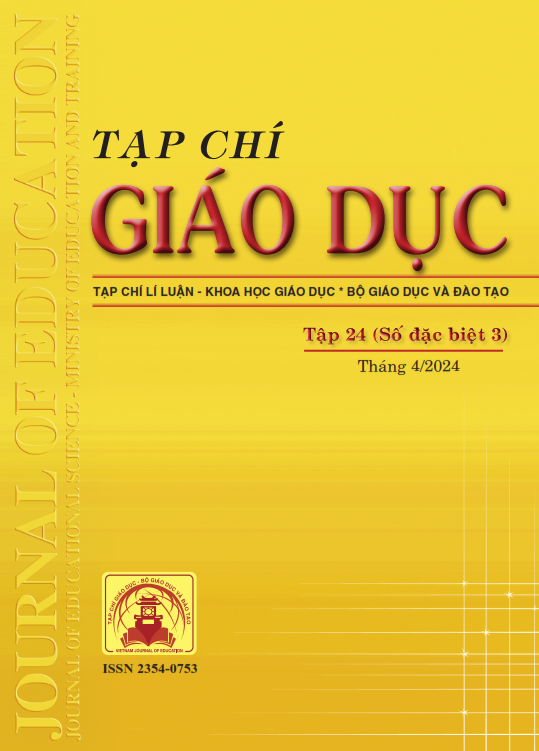Xây dựng ứng dụng thực tế ảo tăng cường trong dạy học kiến thức về đường sức từ trường (Vật lí 12)
Tóm tắt
When imparting knowledge about magnetic fields, teachers have to use flat drawings to describe magnetic field lines in space surrounding magnets and electric currents. The application of augmented reality (AR) technology is a new approach bringing 3D models of magnetic field lines into the real world. In this study, we use the MDLC (Multimedia Development Life Cycle) method to build AR Magnet software on the Android platform with the aim of applying AR technology to visualize 3D models of magnetic field lines on corresponding target images: straight bar magnet, round magnet, current in long straight wire, and current in coil. Through student evaluation, this software helps improve lesson memorization through interaction with AR's images. Based on the effectiveness of the AR Magnet application, we assume that future research will provide toolkits for educational purposes based on AR technology.
Tài liệu tham khảo
Akçayır, M., & Akçayır, G. (2017). Advantages and challenges associated with augmented reality for education: A systematic review of the literature. Educational Research Review, 20, 1-11.
Azuma, R. T. (1997). A survey of augmented reality. Presence: Teleoperators & Virtual Environments, 6(4), 355-385.
Chaudhary, M., Singh, G., Gaur, L., Mathur, N., & Kapoor, S. (2023). Leveraging Unity 3D and Vuforia Engine for Augmented Reality Application Development. 2023 3rd International Conference on Technological Advancements in Computational Sciences (ICTACS), 1139-1144. https://doi.org/10.1109/ICTACS59847. 2023.10390072
Dunleavy, M., Dede, C., & Mitchell, R. (2009). Affordances and limitations of immersive participatory augmented reality simulations for teaching and learning. Journal of Science Education and Technology, 18, 7-22.
eduMedia. (n.d.). eduMedia. https://www.edumedia.com/
George, D., & Mallery, P. (2010). SPSS for Windows Step by Step: A Simple Guide and Reference, 17.0 Update. Allyn & Bacon. Retrieved from https://books.google.com.vn/books?id=KS1DPgAACAAJ
Griffiths, D. J. (2005). Introduction to electrodynamics. American Association of Physics Teachers.
Halliday, D., Resinck, R., & Walker, J. (2008). Cơ sở vật lí. Tập 5: Điện học (tái bản lần 3, người dịch: Nguyễn Viết Kính). NXB Giáo dục.
Kumala, F. N., Ghufron, A., Astuti, P. P., Crismonika, M., Hudha, M. N., & Nita, C. I. R. (2021). MDLC model for developing multimedia e-learning on energy concept for primary school students. Journal of Physics: Conference Series, 1869(1), 12068. IOP Publishing.
Milgram, P., & Kishino, F. (1994). A taxonomy of mixed reality visual displays. IEICE TRANSACTIONS on Information and Systems, 77(12), 1321-1329.
Nguyễn Quang Linh, Trần Quang Hiệu (2023). Quan điểm của giáo viên về việc ứng dụng công nghệ thực tế ảo tăng cường (AR) trong dạy học Vật lí tại các tỉnh miền núi phía Bắc Việt Nam. Tạp chí Giáo dục, 23(21), 7-11.
Nguyễn Thế Khôi, Nguyễn Phúc Thuần (2013). Vật lí 11 nâng cao. NXB Giáo dục.
Purwanti, S., Astuti, R., Jaja, J., & Rakhmayudhi, R. (2022). Application of the Multimedia Development Life Cycle (MDLC) Methodology to Build a Multimedia-Based Learning System. Budapest International Research and Critics Institute-Journal (BIRCI-Journal), 5(1), 2498-2506.
PhET (n.d.). Magnets and Electromagnets. https://phet.colorado.edu/sims/cheerpj/faraday/latest/faraday.html?simulation= magnets-and-electromagnets
Singh, S., & Kaur, A. (2022). Game Development using Unity Game Engine. 2022 3rd International Conference on Computing, Analytics and Networks (ICAN), 1-6. https://doi.org/10.1109/ICAN56228.2022.10007155
Vũ Chí Hiếu, Nguyễn Quang Linh (2023). Khó khăn, thách thức trong sử dụng công cụ công nghệ của giáo viên phổ thông: Nghiên cứu trường hợp tại các tỉnh miền Bắc. Tạp chí Khoa học và Công nghệ, Đại học Thái Nguyên, 228(12), 442-449.
Đã Xuất bản
Cách trích dẫn
Số
Chuyên mục
Giấy phép

Tác phẩm này được cấp phép theo Ghi nhận tác giả của Creative Commons Giấy phép quốc tế 4.0 .












